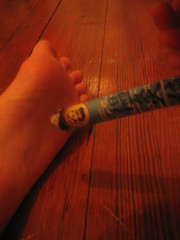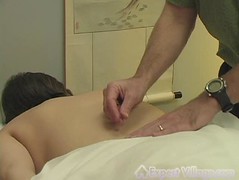I'm starting a new (hopefully) weekly post that will feature a new practitioner in the Portland area. Enjoy! Kim Knight, LAc, is a recent OCOM grad and an incredible practitioner. Here is a brief synopsis of how Portland became so lucky to have her here. You can reach Kim at 503-200-7579, or e-mail her at kim@tensegrityhealth.com
What brought you to Portland?
While living in the Vortex that many call Missoula, Montana, I had a yearning for culture, beauty, color, people and magic. We put out feelers in Seattle, Portland and San Fransisco, and Portland answered! We moved here in 1998 and I have never regretted it. I love Bridgetown and the people that inhabit it. I also enjoy urban living in a city that at the very least attempts to be a good city and in many regards, I think it succeeds admirably!
How did you decide to become an LAc?
Well, of course, as with any of us that is a very long story. I've been involved in medicine in some form since I was young. I was born at home on the couch and my father will tell you that I've always been very interested in nature, biomedicine and anything having to do with our insides. Right after the birth of my son, I became a Dental Assistant and eventually made my way out of that into Homebirth Midwifery because I wanted MORE. I transitioned out of Midwifery because I wanted to go back to school and have more of a foundation.
My plan was to become a N.D., but when I dipped my toe into the great ocean that is Chinese Medicine I was taken, smitten, confused and perplexed into a painfully lifelorn state the led me to the friendly, lovely and eternally supportive Linda Powell's office at the Oregon College of Oriental Medicine. I took a tour that day and after seeing a loving pile of students studying herbs over oolong tea served Gong Fu style, I was hooked.
Tell me about your practice
My business is Tensegrity Health Acupuncture (www.tensegrityhealth.com), located within Owls Nest North Collaboration (www.owlsnestnorth.com), at 3615 NE Grand. Owls Nest North is a socially conscious community of health professionals dedicated to providing safe, responsible and affordable treatment to everyone. Our lineup currently is an amazing and vibrant group consisting of mental health professionals, a massage therapist and myself. I am treating patients currently on Monday afternoons and all day on Tuesday, Thursday and Friday.
The name of the business comes from the Buckminister Fuller word Tensegrity which, while encompassing many ideas is essentially, "Tensional-Integrity." It refers to the integrity of structures as being based in a synergy between balanced tension and compression components. The human body works in this way with the bones and muscles working in balance with the tension between them. This balance way of looking at life communicates the unity of body and mind that is desperately needed in our society today.
I love working with my hands and my practice almost always includes not only acupuncture, but tuina, cupping, guasha and moxa. A typical treatment involves drinking tea while going over the patient's story, what brings them, what concerns they have and just listening to the path that brings them from the beginning to my office. I will then do acupuncture, followed up by the tuina and cupping or guasha.
I greatly enjoy working with all types of patients and while I have a good connection with people of all ages, I work especially well with the elderly and with children.
Where does your passion for the medicine come from?
My hands. I've always taken in information with my hands, enjoyed life as well as reached for life with my hands. As a midwife, I used my hands to bring forth new life, and now as an acupuncturist I find life, connect with it, move it and encourage it with my hands.
One of my closest friends once told me they knew they were an artist when their hands wanted to mould a healed world out of clay. I feel the same way, only my medium is people.
It is absolutely vital to my own well being and happiness that I know, do and rejoice in my own Will. Our world is filled with superstition, tyranny and oppression and I have vowed to fight these things with the tools that I have to the best of my ability. Humbly, I hope to approach this great work in the strongest, most balanced and capable way that I know how, and that is with the applied hermetics of Chinese Medicine.
Any advice for patients?
Have fun! Most of us spend so much of our time just keeping up, I love to see people relax, let their guard down and have fun. I like my treatments to be light and full of energy and laughter. They should have direct communication via discussion, touch and the needling. Be open! Acupuncture is a totally new experience with completely new sensations. Enjoy it! When is the last time you really jumped head first into something new?
What is your favorite Portland restaurant and why?
What a difficult question! Portland is FULL of amazing food! My current favs are Navarre, Cassidy's, and Noble Rot. Mmmmm, Creme Brulee!
If you'd like to be featured as a Portland Practitioner on the Portland Acupuncture Blog, please contact us directly to arrange an interview.

 Photo from: www.portlandmonthlymag.com
Photo from: www.portlandmonthlymag.com


 Photo: Larry Towell/Magnum, for The New York Times
Photo: Larry Towell/Magnum, for The New York Times





 Miriam Lee (left) with her student, Susan Johnson, L.Ac.
Photo taken from: www.tungspoints.com/miriamlee
Miriam Lee (left) with her student, Susan Johnson, L.Ac.
Photo taken from: www.tungspoints.com/miriamlee